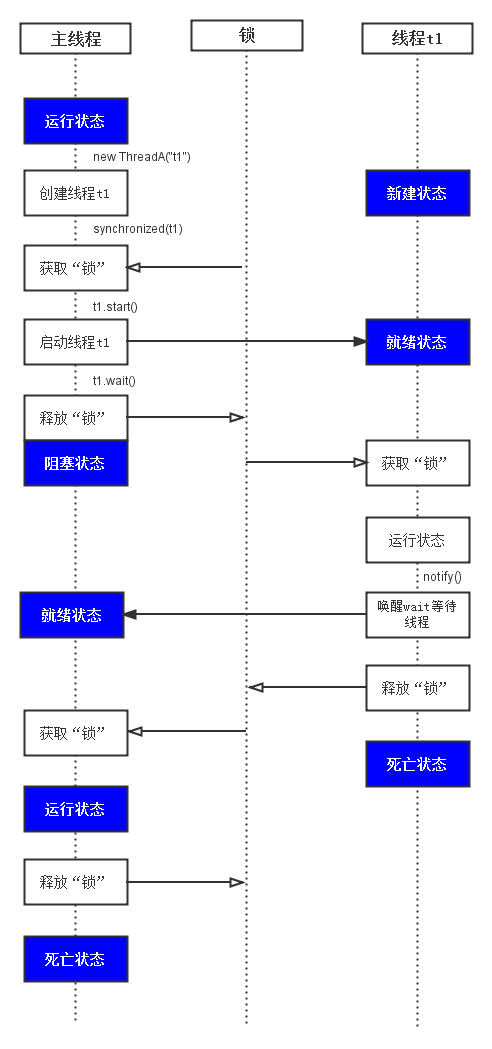wait(), notify(), notifyAll()等方法介紹
在Object.java中,定義了wait(), notify()和notifyAll()等接口。wait()的作用是讓當前線程進入 等待狀態,同時,wait()也會讓當前線程釋放它所持有的鎖。而notify()和notifyAll()的作用,則是喚 醒當前對象上的等待線程;notify()是喚醒單個線程,而notifyAll()是喚醒所有的線程。
Object類中關於等待/喚醒的API詳細信息如下:
notify() -- 喚醒在此對象監視器上等待的單個線程。
notifyAll() -- 喚醒在此對象監視器上等待的所有線程。
wait() -- 讓當前線程處於“等待( 阻塞)狀態”,“直到其他線程調用此對象的 notify() 方法或 notifyAll() 方法”, 當前線程被喚醒(進入“就緒狀態”)。
wait(long timeout) -- 讓當前線程處於“等待(阻塞)狀態”,“直到其他線程調用此對象的 notify() 方法 或 notifyAll() 方法,或者超過指定的時間量”,當前線程被喚醒(進入“就緒狀態”) 。
wait(long timeout, int nanos) -- 讓當前線程處於“等待(阻塞)狀態”, “直到其他線程調用此對象的 notify() 方法或 notifyAll() 方法,或者其他某個線程中斷當前線 程,或者已超過某個實際時間量”,當前線程被喚醒(進入“就緒狀態”)。
2. wait()和notify()示例
下面通過示例演示"wait()和notify()配合使用的情形"。
// WaitTest.java的源碼
class ThreadA extends Thread{
public ThreadA(String name) {
super(name);
}
public void run() {
synchronized (this) {
System.out.println(Thread.currentThread().getName()+" call notify()");
// 喚醒當前的wait線程
notify();
}
}
}
public class WaitTest {
public static void main(String[] args) {
ThreadA t1 = new ThreadA("t1");
synchronized(t1) {
try {
// 啟動“線程t1”
System.out.println(Thread.currentThread().getName()+" start t1");
t1.start();
// 主線程等待t1通過notify()喚醒。
System.out.println(Thread.currentThread().getName()+" wait()");
t1.wait();
System.out.println(Thread.currentThread().getName()+" continue");
} catch (InterruptedException e) {
e.printStackTrace();
}
}
}
}
運行結果:
main start t1
main wait()
t1 call notify()
main continue
結果說明:
如下圖,說明了“主線程”和“線程t1”的流程。
(01) 注意,圖中"主線程" 代表“主線程main”。"線程t1" 代表 WaitTest中啟動的“線程t1”。 而“鎖” 代表“t1這個對象的同步鎖 ”。
(02) “主線程”通過 new ThreadA("t1") 新建“線程t1”。隨後 通過synchronized(t1)獲取“t1對象的同步鎖”。然後調用t1.start()啟動“線程 t1”。
(03) “主線程”執行t1.wait() 釋放“t1對象的鎖”並且進入“等待(阻 塞)狀態”。等待t1對象上的線程通過notify() 或 notifyAll()將其喚醒。
(04) “線程t1”運行之後,通過synchronized(this)獲取“當前對象的鎖”; 接著調用notify()喚醒“當前對象上的等待線程”,也就是喚醒“主線程”。
(05) “線程t1”運行完畢之後,釋放“當前對象的鎖”。緊接著,“主 線程”獲取“t1對象的鎖”,然後接著運行。

查看本欄目
對於上面的代碼?曾經有個朋友問到過:t1.wait()應該是讓“線程t1”等待;但是,為什 麼卻是讓“主線程main”等待了呢?
在解答該問題前,我們先看看jdk文檔中關於wait的一段介紹:
Causes the current thread to wait until another thread invokes the notify() method or the notifyAll() method for this object.
In other words, this method behaves exactly as if it simply performs the call wait(0).
The current thread must own this object's monitor. The thread releases ownership of this monitor and waits until another thread notifies threads waiting on this object's monitor to wake up either through a call to the notify method or the notifyAll method. The thread then waits until it can re-obtain ownership of the monitor and resumes execution.
中文意思大概是:
引起“當前線程”等待,直到另外一個線程調用notify()或notifyAll()喚醒該線程。換句 話說,這個方法和wait(0)的效果一樣!(補充,對於wait(long millis)方法,當millis為0時,表示無限 等待,直到被notify()或notifyAll()喚醒)。
“當前線程”在調用wait()時,必須擁有該對象的同步鎖。該線程調用wait()之後,會釋 放該鎖;然後一直等待直到“其它線程”調用對象的同步鎖的notify()或notifyAll()方法。 然後,該線程繼續等待直到它重新獲取“該對象的同步鎖”,然後就可以接著運行。
注意:jdk的解釋中,說wait()的作用是讓“當前線程”等待,而“當前線程” 是指正在cpu上運行的線程!
這也意味著,雖然t1.wait()是通過“線程t1”調用的wait()方法,但是調用t1.wait()的 地方是在“主線程main”中。而主線程必須是“當前線程”,也就是運行狀態,才 可以執行t1.wait()。所以,此時的“當前線程”是“主線程main”!因此, t1.wait()是讓“主線程”等待,而不是“線程t1”!
3. wait(long timeout)和notify()
wait(long timeout)會讓當前線程處於“等待(阻塞)狀態”,“直到其他線程調用此 對象的 notify() 方法或 notifyAll() 方法,或者超過指定的時間量”,當前線程被喚醒(進入 “就緒狀態”)。
下面的示例就是演示wait(long timeout)在超時情況下,線程被喚醒的情況。
// WaitTimeoutTest.java的源碼
class ThreadA extends Thread{
public ThreadA(String name) {
super(name);
}
public void run() {
System.out.println(Thread.currentThread().getName() + " run ");
// 死循環,不斷運行。
while(true)
;
}
}
public class WaitTimeoutTest {
public static void main(String[] args) {
ThreadA t1 = new ThreadA("t1");
synchronized(t1) {
try {
// 啟動“線程t1”
System.out.println(Thread.currentThread().getName() + " start
t1");
t1.start();
// 主線程等待t1通過notify()喚醒 或 notifyAll()喚醒,或超過3000ms延時;然後才
被喚醒。
System.out.println(Thread.currentThread().getName() + " call wait
");
t1.wait(3000);
System.out.println(Thread.currentThread().getName() + "
continue");
} catch (InterruptedException e) {
e.printStackTrace();
}
}
}
}
運行結果:
main start t1 main call wait t1 run // 大約3秒之後...輸出“main continue” main continue
結果說明:
如下圖,說明了“主線程”和“線程t1”的流程。
(01) 注意,圖中"主線程" 代表WaitTimeoutTest主線程(即,線程main)。"線程 t1" 代表WaitTest中啟動的線程t1。 而“鎖” 代表“t1這個對象的同步鎖 ”。
(02) 主線程main執行t1.start()啟動“線程t1”。
(03) 主線程main執行t1.wait(3000),此時,主線程進入“阻塞狀態”。需要“用於 t1對象鎖的線程通過notify() 或者 notifyAll()將其喚醒” 或者 “超時3000ms之後” ,主線程main才進入到“就緒狀態”,然後才可以運行。
(04) “線程t1”運行之後,進入了死循環,一直不斷的運行。
(05) 超時3000ms之後,主線程main會進入到“就緒狀態”,然後接著進入“運行狀 態”。

4. wait() 和 notifyAll()
通過前面的示例,我們知道 notify() 可以喚醒在此對象監視器上等待的單個線程。
下面,我們通過示例演示notifyAll()的用法;它的作用是喚醒在此對象監視器上等待的所有線程。
public class NotifyAllTest {
private static Object obj = new Object();
public static void main(String[] args) {
ThreadA t1 = new ThreadA("t1");
ThreadA t2 = new ThreadA("t2");
ThreadA t3 = new ThreadA("t3");
t1.start();
t2.start();
t3.start();
try {
System.out.println(Thread.currentThread().getName()+" sleep(3000)");
Thread.sleep(3000);
} catch (InterruptedException e) {
e.printStackTrace();
}
synchronized(obj) {
// 主線程等待喚醒。
System.out.println(Thread.currentThread().getName()+" notifyAll()");
obj.notifyAll();
}
}
static class ThreadA extends Thread{
public ThreadA(String name){
super(name);
}
public void run() {
synchronized (obj) {
try {
// 打印輸出結果
System.out.println(Thread.currentThread().getName() + "
wait");
// 喚醒當前的wait線程
obj.wait();
// 打印輸出結果
System.out.println(Thread.currentThread().getName() + "
continue");
} catch (InterruptedException e) {
e.printStackTrace();
}
}
}
}
}
運行結果:
t1 wait main sleep(3000) t3 wait t2 wait main notifyAll() t2 continue t3 continue t1 continue
結果說明:
參考下面的流程圖。
(01) 主線程中新建並且啟動了3個線程"t1", "t2"和"t3"。
(02) 主線程通過sleep(3000)休眠3秒。在主線程休眠3秒的過程中,我們假設"t1", "t2"和"t3"這3個線程都運行了。以"t1"為例,當它運行的時候,它會 執行obj.wait()等待其它線程通過notify()或額nofityAll()來喚醒它;相同的道理,"t2"和 "t3"也會等待其它線程通過nofity()或nofityAll()來喚醒它們。
(03) 主線程休眠3秒之後,接著運行。執行 obj.notifyAll() 喚醒obj上的等待線程,即喚醒 "t1", "t2"和"t3"這3個線程。 緊接著,主線程的synchronized(obj) 運行完畢之後,主線程釋放“obj鎖”。這樣,"t1", "t2"和 "t3"就可以獲取“obj鎖”而繼續運行了!

5. 為什麼notify(), wait()等函數定義在Object中,而不是Thread中
Object中的wait(), notify()等函數,和synchronized一樣,會對“對象的同步鎖”進行 操作。
wait()會使“當前線程”等待,因為線程進入等待狀態,所以線程應該釋放它鎖持有的 “同步鎖”,否則其它線程獲取不到該“同步鎖”而無法運行!
OK,線程調用wait()之後,會釋放它鎖持有的“同步鎖”;而且,根據前面的介紹,我們 知道:等待線程可以被notify()或notifyAll()喚醒。現在,請思考一個問題:notify()是依據什麼喚醒 等待線程的?或者說,wait()等待線程和notify()之間是通過什麼關聯起來的?答案是:依據“對 象的同步鎖”。
負責喚醒等待線程的那個線程(我們稱為“喚醒線程”),它只有在獲取 “該對象的同步鎖”(這裡的同步鎖必須和等待線程的同步鎖是同一個), 並且調用notify()或notifyAll()方法之後,才能喚醒等待線程。雖然,等待線程被喚醒;但是,它不能 立刻執行,因為喚醒線程還持有“該對象的同步鎖”。必須等到喚醒線程釋放了“對象 的同步鎖”之後,等待線程才能獲取到“對象的同步鎖”進而繼續運行。
總之,notify(), wait()依賴於“同步鎖”,而“同步鎖”是對象鎖持有,並 且每個對象有且僅有一個!這就是為什麼notify(), wait()等函數定義在Object類,而不是Thread類中的 原因。